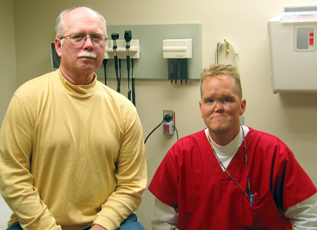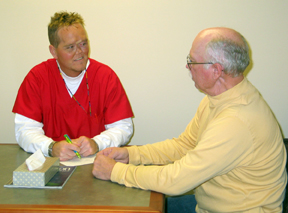 |
Richard Bean, left, and Jason Schoo. |
The two men also share another bond – they are both survivors of head and neck cancer, the most disfiguring form of cancer.
Schoo had olfactory neuroblastoma, a tumor involving the smelling nerve. It developed into a more aggressive form of cancer called adenocarcinoma. He lost much of the middle of his face, including the nasal bone, the nasal septum and the left side of his hard palate. His makeshift nose is topped with a couple of band-aid strips that basically cover a hole in his face that can’t be closed.
Bean was more fortunate than Schoo. He had a cancerous tumor in his saliva glands. His face looks normal. His only abnormality is that the left side of his neck appears sunken and out of proportion with the right side.
Schoo has been dealing with his cancer for nearly 11 years, while Bean is nearly a five-year survivor. Schoo, 33, works in the Specialty Care Clinic at The Nebraska Medical Center as a certified medical assistant. His job is to help others through the misery and agony that is head and neck cancer. Bean, 59, lives in Fremont and is retired from the heating and air conditioning business.
 |
Jason Schoo, left, talks with fellow head and neck cancer survivor Richard Bean. |
Bill Lydiatt, M.D., a head and neck cancer surgeon at UNMC, also sings Schoo’s praises.
“Jason has a unique ability to reassure patients that it may be a tough road, but you can make it like he did,” he said. “Jason is the first clinical person the patient meets. He starts the entire relationship with our patients. This initial interaction is key to a successful relationship.”
The sign above Schoo’s office door says it all. It reads: Live-Laugh-Love. “I love to get patients talking to one another.to get them laughing,” he said. “I’m there as a friend. I’m there to listen to what their problems are.to be someone they can reach out and tell their inner thoughts to.
“I know how isolated they feel. I tell them, ‘Don’t be bitter. You didn’t do anything to deserve this.’ I can find out instantly who is depressed, then I try to get them to open up and help them work through their problems.”
Schoo’s battle with cancer began in 1995. He was 22 years old and a senior majoring in business management accounting at Newman University in Wichita, Kan. A three-sport athlete in high school, Schoo was attending Newman on a golf scholarship. His high school resume had included winning the Class B state golf championship in Nebraska. He also had played basketball and baseball and competed in the Junior Olympics in San Antonio along with a fellow by the name of Shaquille O’Neal.
He’d been battling a sinus infection for four months. From time to time, a bump would appear on the side of his nose, but then would go away.
He woke up one night and unleashed what he calls “a powerful sneeze.” He turned on the light to find a “ping pong ball-sized blood clot in my hand.” Although he tossed it away, the blood clot was likely part of his tumor, he said.
Knowing something was seriously wrong, Schoo packed his bags the next morning and drove back to his parents’ home in Columbus, Neb.
Within a few days, the cancer diagnosis was made, and Schoo’s world was about to turn upside down. He had to drop out of school to undergo months of treatment – first at UNMC and then at M.D. Anderson Cancer Center in Houston.
By the time Schoo got to M.D. Anderson, his prognosis was bleak. Doctors told him he had less than six months to live. A team of about 30 physicians handled Schoo’s case. “I was a guinea pig. They had never seen a case like mine,” he said. “I wanted to make it in golf, not in the medical books.”
Miraculously – after 12 surgeries and countless chemotherapy and radiation treatments – Schoo pulled through. At one point, he was stunned as doctors pulled out 17-feet of packing from his empty sinus cavity. “It was amazing,” he said. “It was like one of those magic tricks where the magician pulls out a red rag, then a blue one, then a green one.”
He returned to Nebraska – sense of humor intact, but looking into a mirror wasn’t easy. “It’s depressing,” he said. “It’s your face. It’s demoralizing. It took me three years to walk out in public.”
Eventually, after working in Lincoln installing underground sprinklers, Schoo returned to Omaha and decided it was time to go back to school and get on with his life. His interests had changed, and he now wanted to pursue a career in health care.
He took several radiology courses at Clarkson College and eventually graduated from Vatterott College as a certified medical assistant. Shortly after he graduated, a UNMC oncology nurse called Vatterott looking for someone who might be interested in working in the UNMC Cancer Center.
After a few months in the cancer center, Schoo moved to the Specialty Care Clinic in November 2003 to take on his present position working with head and neck cancer patients.
It’s been a good fit, he said. Who better to help these patients than someone who stared death in the face and now wears a permanent smile 10 years later?
“It’s only natural for people to stare when they see my face, but I have to keep laughing,” Schoo said. “I have a T-shirt that I sometimes wear. It says, ‘Keep staring. I may do a trick.'”
The one-liners don’t end there. Schoo said the band-aid strips covering the hole at the top of his nose were actually a forerunner to the new gimmick of putting advertising on one’s forehead. He said he wants to go on the David Letterman Show. “I’d do one of those stupid human tricks,” he said. “Ever see anyone drink a soda through their forehead?”
Richard Bean knows what Schoo is all about, as do many other head and neck cancer patients going through The Nebraska Medical Center. “He’s special,” Bean said. “We’ve developed a relationship over the years. He can relate to other people’s problems.”
Meanwhile, Schoo carries on – at peace with the lousy hand that life dealt him. “I know this is what I’m supposed to be doing,” he said. “The greatest thing is to get a hug from a patient. They say, ‘This hug is good until I see you again.’ ”
Art exhibit, speaker series highlights head and neck cancer patients
The public is invited to view a unique art exhibition that provides an in-depth look at the physical and emotional aspects of patients who undergo head and neck surgery due to cancer or trauma. The exhibition, called “Saving Faces: Art and Medicine,” will be on display at the University of Nebraska at Omaha Art Gallery on the north end of the Weber Fine Arts Building from Jan. 13 to Feb. 24.
The exhibition features 42 portraits – some nearly six-feet tall – by Scottish artist Mark Gilbert. The portraits show patients before, during and after reconstructive facial surgery.
There is no admission charge to view the exhibit. In addition, a five-part speaker series will complement the exhibition. The series, which also is free and open to the public, will explore the integration of art and medicine and the nature of healing.
The first speaker will be Iain Hutchinson, M.D., the British surgeon whose patients are featured in the exhibition. He will speak at 7 p.m., Friday, Jan. 13, at the Weber Fine Arts Theater in the south end of the Weber Fine Arts Building at UNO.
The other four speaking dates will be: Jan. 19 at the UNMC Eppley Science Hall Amphitheater; Jan. 26 at the Scott Conference Center, 6450 Pine St. (UNO South campus); Feb. 9 and Feb. 16 at the UNO Art Gallery. All of the presentations begin at 7 p.m. Complete details on the speaker series are available on the Web.
The opening public exhibition and reception will be from 2 to 4 p.m., Jan. 15, at the UNO Art Gallery. The UNO Art Gallery is closed on Saturdays and Mondays. It is open: noon to 4 p.m. on Tuesdays, Wednesdays and Fridays; noon to 8 p.m. on Thursdays; and 2 to 5 p.m. on Sundays.
For more information about the exhibition and speaker series, contact Virginia Aita, Ph.D., UNMC department of preventive and societal medicine, 559-5157, or Deborah-Eve Lombard, director of the UNO Art Gallery, 554-2796.